|
Displaying items by tag: netherlands
The court case begins today in Amsterdam to determine the future of a collection of gold, precious gems, a ceremonial helmet, and other treasures from the Black Sea region. Four different museums in Crimea are taking legal action to force the Allard Pierson Museum in the Netherlands to give back treasures in an exhibition entitled, The Crimea: Gold and Secrets from the Black Sea, loaned before Russia annexed the Ukrainian territory. The Netherlands does not recognize the Russian annexation of Crimea.
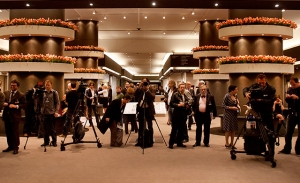
The European Fine Art Foundation, organizers of the venerable European Fine Art Fair (TEFAF), which is held annually in Maastricht, Netherlands, have been discussing launching a new art fair in China with the help of Sotheby’s. While it may seem like an unusual pairing, TEFAF and Sotheby’s are looking to join forces in order to tap into China’s thriving art and antiques market, which raised $13.7 billion in 2012.
Last year, Sotheby’s entered into a ten-year joint venture with China’s state-owned media corporation, Beijing GeHua Cultural Development Group. The collaboration will allow Sotheby’s to utilize the free port that GeHua is developing with the Tianzhu Free Trade Zone in Beijing. The port will serve as a tax-advantaged storage location, which is ideal for foreigners looking to buy high-priced artworks overseas. Sotheby’s is the first international auction house to establish itself in Mainland China.
If TEFAF and Sotheby’s decide to move forward with the fair, TEFAF Beijing will launch in 2014. TEFAF Maastricht, the world’s biggest art and antiques fair, is currently taking place in the Netherlands and will wrap up on Sunday, March 24, 2013.
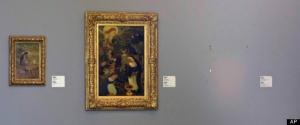
A 46-year-old German man was arrested by authorities in connection to the devastating art heist that took place in the Netherlands on October 16, 2012. The man was arrested in southwestern Germany for allegedly trying to sell the seven stolen paintings back to the Triton Foundation, the owner of the artworks.
The paintings, which include masterpieces by Pablo Picasso (1881-1973), Claude Monet (1840-1926), Henri Matisse (1869-1954), and Paul Gauguin (1848-1903), were on view at the Kunsthal Museum in the Netherlands and have yet to be recovered. The bounty, which includes Picasso’s Harlequin Head (1971), Monet’s Waterloo Bridge, London and Charing Cross Bridge, London (1901), and Matisse’s Reading Girl in White and Yellow (1919), is believed to be worth between $66 million and $266 million.
This is the fifth arrest made in connection to the heist; three Romanian men accused of carrying out the heist were arrested on January 22, 2013 and a Romanian woman was arrested on March 4, 2013 on suspicion of assisting the robbers. Officials are working to determine whether the German suspect had ties to the stolen paintings or was simply trying to scam the Triton Foundation. He was arrested on the grounds of suspected blackmail and is currently under investigation.
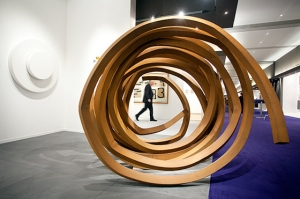
China’s art market experienced a substantial boom in 2011, bumping the United States out of its top spot and ultimately becoming the world’s principal market for art and antiques. In 2012, amid the uncertain global economy, China’s growth began to slow and its art and antiques market shrank by almost a quarter. This deceleration allowed the U.S. to regain its title as the world’s most significant art market.
The power shift was announced as part of the highly anticipated TEFAF Art Market Report compiled by Dr. Clare McAndrew. McAndrew, a cultural economist who specializes in the fine and decorative art market, is the founder of Arts Economics, a company commissioned by The European Fine Art Foundation to provide a yearly analysis of the worldwide art market. The report coincides with the beginning of TEFAF Maastricht, the Foundation’s annual art fair, which begins March 15, 2013 in the Netherlands and runs through March 24, 2013.
Slowing economic growth and a lack of high quality, high priced items on the market are to blame for China’s slip to the second most influential art market. While auction sales dropped by 30% in China, U.S. sale figures were up 5% to $18.4 billion. In 2012, buyers opted to minimize financial risk by buying works by well-known artists at the top end of the market with Post-War and Contemporary art performing the strongest.
Dr. McAndrew will present her findings at the TEFAF Art Symposium on Friday, March 15, 2013 in Maastricht.
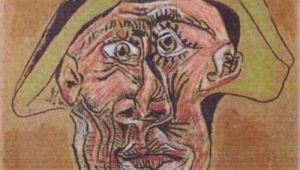
A Romanian woman has been arrested in Rotterdam in connection to an art heist that rocked the Netherlands in October 2012. The 19-year-old woman, who is the girlfriend of one of the three suspects currently being held in Romania for alleged involvement in the heist, is thought to have helped the thieves haul the seven stolen masterpieces out of the country.
Police claim that after the robbery, the paintings were taken to a home in Rotterdam where the frames were removed. The paintings were later taken to Romania where prosecutors are investigating the mother of one of the suspects who claims that she burned two of the stolen works.
The robbery, which took place at the Kunsthal museum, was the biggest art theft in two decades in the Netherlands. The stolen works, which are part of the private Triton Foundation collection, include masterpieces by Pablo Picasso (1881-1973), Claude Monet (1840-1926), Henri Matisse (1869-1954), and Paul Gauguin (1848-1903) and are believed to be worth between $66 million and $266 million. Among the masterpieces lifted by the thieves were Picasso’s Harlequin Head (1971), Monet’s Waterloo Bridge, London and Charing Cross Bridge, London (1901), and Matisse’s Reading Girl in White and Yellow (1919).
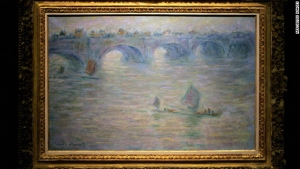
Major paintings by such artists as Pablo Picasso, Claude Monet, and Henri Matisse were stolen from Rotterdam’s Kunsthal Museum on Tuesday. The thieves, who ransacked the museum in the early hours of the morning made off with seven works that may total hundreds of millions of dollars.
The heist is the largest in years for the Netherlands and includes Picasso’s Tete d’Arlequin, Matisse’s La Liseuse en Blanc et Jaune, Monet’s Waterloo Bridge, London and Charing Cross Bridge, London, Gauguin’s Femme devant une fenetre ouverte, dite la Fiancee, Meyer de Haan’s Autoportrait, and Lucian Freud’s Woman with Eyes Closed.
The works belong to The Triton Collection, a private collection that is being shown to the public for the first time ever as part of the Museum’s 20th anniversary celebration. The Triton Collection was assembled over a twenty-year period and includes 150 works of modern art spanning from the 19th century to the present day.
The Kunsthal’s alarm went off at 3AM and Rotterdam police have secured evidence from the scene. The police are speaking with potential witnesses and investigators are looking into the security camera footage.
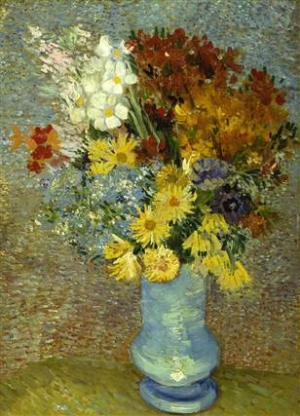
When Vincent van Gogh painted Flowers in a Blue Vase in 1887 in Paris, he chose a bright, cheery yellow for the flowers. As years passed, the vivid hue faded to a dull orange-gray and scientists have just found out that a coat of protective varnish is to blame.
After van Gogh’s death in 1890, the varnish was applied to preserve the work, a common practice at the time. However, when the paint mixed with the varnish, a chemical reaction occurred causing the colors to change.
Something seemed awry back in 2009 when Margje Leeuwestein, painting conservator at the Kröller-Müller Museum in the Netherlands, attempted a conversation treatment on the piece. An unusual gray crust containing cadmium yellow paint formed on the surface, signaling that they were dealing with more than just aging varnish which is known to darken over time.
As the painting had become increasingly brittle, experts at the Kröller-Müller Museum carefully took two microscopic paint samples from the original work and used X-ray beams to determine the chemical composition and structure where the paint and varnish met. A lead-sulfate compound, the result of photo-oxidation that separates cadmium and sulfate ions from that particular paint, was revealed. The researchers deduced that the negatively charged sulfate ions hooked up with the lead ions in the varnish to form anglesite, an opaque lead-sulfate compound that caused the color to transform.
By keeping the painting in lower light conditions and using more advanced varnish, the deterioration should be halted. The surprising findings will be chronicled in the upcoming issue of the scholarly journal, Analytical Chemistry.
|
|
|
|
|